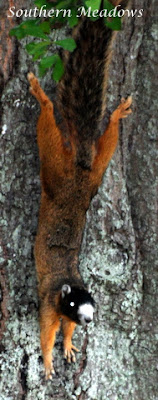Ants. Unlikely Pollinators
Some plants and insects go unnoticed most of the time. Often sitting under taller trees and shrubs in a woodland setting minding their own business is Euonymus americanus. Know by it's common name strawberry bush or in my part of the world hearts a burstin', this bush comes into the spotlight in fall because of its incredible fruit which burst out of deep pink capsules and are eaten by songbirds and wild turkey. (warning: should not be ingested by humans as they are considered poisonous)
In spring a careful observer will spy its little pale blossoms. As you can see they are not very eye catching and would go completely unnoticed if they weren't so abundant.
Look even closer and you will find there are ants sprawling all over the blooms. Red ants, black ants. It's bustling with activity.
And, these ants don't stay at one bloom for long. Scurrying along with a real sense of urgency.
Feeding on the nectar these blooms provide. And inadvertently pollinating? That is the question.
I can almost see some pollen grains sticking to the tiny hairs on the ants abdomen. It's easiest to see on the black ants. While these ants collect the energy rich nectar I see them vibrate their abdomen, possibly collecting and redistributing pollen.
Everything I read says that ants are not effective pollinators. They are more likely to take nectar without cross-pollinating flowers. Plus, some ants secrete a natural substance that protects them from bacterial and fungal infections acting like an antibiotic. Unfortunately for the flowers this secretion can also kill a pollen grain pretty quickly.
So are these social insects pollinators? Well, my Euonymus americanus was full of fruit last fall and as far as I can tell the ants are the only things pollinating these inconspicuous blooms.
 |
In spring a careful observer will spy its little pale blossoms. As you can see they are not very eye catching and would go completely unnoticed if they weren't so abundant.
Look even closer and you will find there are ants sprawling all over the blooms. Red ants, black ants. It's bustling with activity.
And, these ants don't stay at one bloom for long. Scurrying along with a real sense of urgency.
Feeding on the nectar these blooms provide. And inadvertently pollinating? That is the question.
I can almost see some pollen grains sticking to the tiny hairs on the ants abdomen. It's easiest to see on the black ants. While these ants collect the energy rich nectar I see them vibrate their abdomen, possibly collecting and redistributing pollen.
Everything I read says that ants are not effective pollinators. They are more likely to take nectar without cross-pollinating flowers. Plus, some ants secrete a natural substance that protects them from bacterial and fungal infections acting like an antibiotic. Unfortunately for the flowers this secretion can also kill a pollen grain pretty quickly.
So are these social insects pollinators? Well, my Euonymus americanus was full of fruit last fall and as far as I can tell the ants are the only things pollinating these inconspicuous blooms.






.png)
